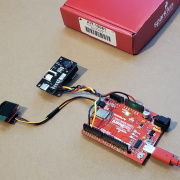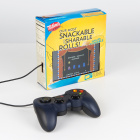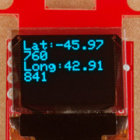Brandon J. Williams
Member Since: September 4, 2018
Country: United States
Once upon a time it was monsters hidden in the barcodes of everyday items, but now there are electronic components stuck inside. Using the RedBoard Artemis, Barcode Scanner Breakout and Qwiic Micro OLED Display, we can unlock them for a fun game.
In a new tutorial we'll revisit some RFID basics, and practice by making a remote work logger using an RFID reader and a GPS module.
We added a follow-up GPS tutorial to increase your GPS skills a few weeks ago. Now we want to show you a practical example with a handheld GPS coordinate logger that will pin locations for your viewing pleasure using Google Earth.
RFID Beginners Tutorial
June 15, 2020
Make a remote work logger using an RFID reader and a GPS module. Scan a card and get ID, location, and time. All the perfect data to punch in and punch out from the middle of Nowhere!
Basic LED Animations for Beginners (Arduino)
December 3, 2019
Let's have some fun with LEDs! We'll explore LEDs once again with the SparkFun RedBoard Qwiic, making cool effects, and putting those effects to work using a sensor.
GPS Geo-Mapping at the Push of a Button
September 27, 2019
Let's ramp up our GPS tracking skills with KML files and Google Earth. We'll make a tracker that logs location and allows us to visualize our steps with Google Earth.
Displaying Your Coordinates with a GPS Module
April 30, 2019
This Arduino tutorial will teach you how to pinpoint and display your GPS coordinates with a press of a button using hardware from our Qwiic Connect System (I2C).
-
Yes, it's Arduino compatible. Check out the example section 'Blink': https://learn.sparkfun.com/tutorials/micromod-all-the-pins-atp-carrier-board#example
-
I've removed the 9V battery from the hardware list. Thank you for catching the error.
-
You are absolutely right! Thank you for catching that. The module I used for testing worked with the 9V battery oddly enough. It can be safely assumed that my unit was an exception for an unknown reason. I will update this tutorial as soon as possible!
Note for future users: please use a lipo battery or battery pack <= 6V.
-
That's how you know they're handmade!
-
In theory you could try to use our LTE CAT Shield ( https://www.sparkfun.com/products/15087?_ga=2.6280051.1178768999.1572880791-5961796.1565817435 ) for more internet connectivity. We also have some LoRa options in a tutorial post if you'd like to explore those possibilities, https://learn.sparkfun.com/tutorials/what-is-gps-rtk?_ga=2.17815545.1178768999.1572880791-5961796.1565817435 . Your idea would still be awesome to have. I hope one day you'll be able to implement it.
-
Absolutely! That would be a great idea.
-
Addressing your project idea: That sounds awesome! I'd like to use an RTK receiver to plot an elevation view of some of my favorite hiking areas (and maybe yard uses for landscaping). Make sure to tag us if you ever post images or updates on the project on social media!
That peak, I believe, is Hahns Peak. The lake is just a few miles north of Steamboat Lake State Park ( https://www.google.com/maps/place/Hahns+Peak+Lake/@40.8382146,-106.9954651,16z/data=!3m1!4b1!4m5!3m4!1s0x8742edc590e97ca7:0xcbe3430f2e93b25f!8m2!3d40.8359287!4d-106.9893594 ). Unfortunately that photo is the only one I have in high resolution. It was originally taken with my phone.
-
Maybe my puns are too strong, but I think you missed a great chance to use a pie box instead.
-
There should now be an updated copy of the code with the revisions. Thank you for catching that!
-
That's an awesome project! I worked on something similar when I was still in college for a senior project. I'm not entirely sure if we have a direct ozone product, but I had used a Spec Ozone sensor. However, I didn't have much luck trying to integrate it into a larger circuit back then. I don't think it'll match your desired tolerance, but it'd be a good place to look if you haven't already.
I wish you the best of luck!









































